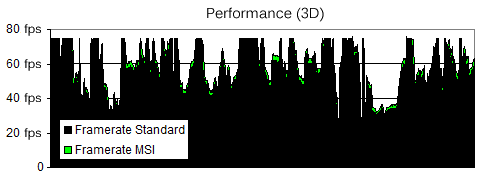Comparison: Factory-Overclocked Versus Reference Graphics
In order to set their products apart, third-party vendors take reference GPUs from AMD and Nvidia, then make their own tweaks to layout, cooling, and performance. We're comparing a tuned-up card from MSI to AMD's reference Radeon HD 5870 to measure value.
Overclocking
First things first: the performance gains you get when you spend an extra $100 on an overclocked card are quite limited, which is due to the relatively small clock speed boost of 850 to 900 MHz that equals only 6%. In our gaming benchmarks this translated into an even smaller 1.5% gain (hardly worth a 25% increase in cost).
On the reference card, we reached the same 900 MHz, but we also accelerated the video memory from 1,200 to 1,300 MHz, which results in a more significant performance benefit of 4.5%. Last but not least, we also overclocked MSI’s R5870 Lightning to 925 MHz on the GPU and 1,315 MHz on the GDDR5 video memory, which resulted in a performance advantage of 5.4% when compared to reference clock speeds. That's an extra .9% gain overall.
As you can imagine, the MSI R5870 Lightning doesn’t hit physical limits at these speeds. You can use the Afterburner tool to tweak voltages in an effort to reach higher overclocking speeds. Once you enable voltage control in the settings window, you will be able to modify an additional slider in Afterburner. The default GPU voltage setting for MSI’s R5870 Lightning card is 1.129 V. We decided to finalize this article without voltage increases, because the potential performance increase is disproportional to the strain the card has to endure. We needed more than 1.2 V to make sure 950 MHz would work reliably, and this came at the cost of 73°C GPU temperature. All you would be getting is a mere 1% performance boost, which is not quite exciting. The memory could hardly be overclocked any further than 1,315 MHz. The TwinFrozr II fan will also be running at increased speeds, generating more noise. Our recommendation is to use the voltage control for ensuring stability at slight overclocks instead of going for maximum clock speeds.
The performance diagram shows the frame rates during the 13 minutes benchmark duration. The black area shows the performance of the reference card. The green peaks represent the additional performance of the overclocked retail card. You can see that there is additional performance at low as well as at high frame rates. We used a 1920x1200 resolution with 8x anti aliasing.
Get Tom's Hardware's best news and in-depth reviews, straight to your inbox.
-
rohitbaran Too less performance gain (4-5 FPS) for the too much extra price paid ($50-$70) along with too much increase in power consumption (30-40 W. Better to buy a reference card unless you want the best no matter what the price is.Reply -
Mark Heath I like the idea behind the article and I'm glad that there's been some testing done on it, but I don't really like the article itself.Reply
There are references to how much the reference card is overclocked by, but there is no clear section about it, you started off with some of the summary charts, instead of putting them after the initial tests and you kept switching what cards you were comparing, with less warning than I would like..
Plus there's that 2GB 5850. Is that really a 2GB 5850, or is it actually 2GB 5830, because it kept getting beaten by the 1GB 5850..
-
Onus When I buy a new GPU, I look for one who's reference clocks make it "good enough" as-is; but I do look for a better / quieter cooler.Reply -
mrhoshos96 great article but u should have compared the reference against the sapphire vapor-xReply -
Tesla1483 ReplyIn order to their products apart, third-party vendors take reference GPUs...
I'm guessing they meant "In order to SET their products apart..."
Seriously, it's the first sentence in the article. Does no one proof read anything here? Isn't that like the first thing you learn when you want to become a writer? Sorry, rant over. -
youssef 2010 "This cooling concept works pretty well, as it not only provides effective graphics component cooling, but it also helps to remove warm air from the inside of your PC. "Reply
The reference 5870 has a vent on its side so, it doesn't completely remove the hot air from the case but recirculates a part of the hot air back into the case -
duk3 It's a 5850, look how close the framerates are.Reply
The amount of ram doesn't really matter at these resolutions. -
LLJones The cards just do not offer enough gain. If you can afford the overclock edition at a premium, then save up a little more and get the next card up or buy two of the next lower cards. The $1000+ dual 5870 from Asus shows what a complete waste of money some, not all, super OC cards are.Reply
Try this, put together a really really really premium card component wise, and then don't put any cooling on it. Let me decide what I am going to do for cooling and companies can save on packaging, shipping etc due to no cooler.
If your really aiming at the OC crowd and not just playing a game of marketing, then you know the first thing someone does is to rip off your factory cooler to replace it or at the very least put quality thermal compound on it.


